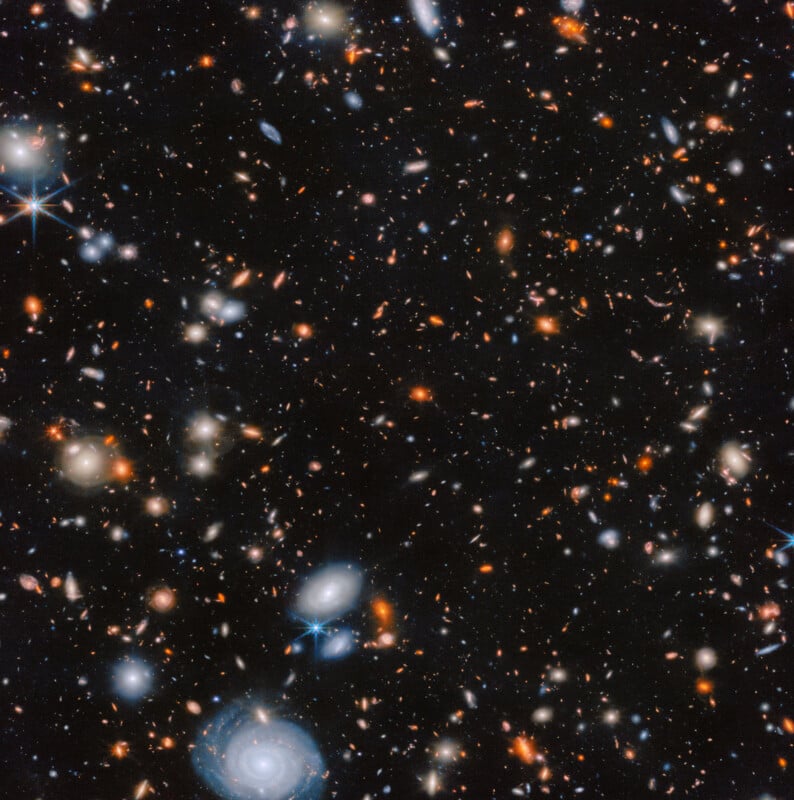Webb Found an Ancient, Greedy Black Hole Growing Too Fast

Scientists using the NASA/ESA/CSA James Webb Space Telescope (JWST) have confirmed the presence of an actively growing supermassive black hole in a galaxy observed just 570 million years after the Big Bang. It’s a greedy blackhole, consuming matter and growing at a shocking rate that flies in the face of expectations.
The supermassive blackhole is in the ancient, distant galaxy CANUCS-LRD-z8.6. While its name is a mouthful, the galaxy is part of a broader class of “Little Red Dot” (LRD) galaxies. These “tantalizing” galaxies are mysterious and, despite their unexpectedly large number, difficult to study.
The primary challenge with LRDs is that they are so old and so far away. CANUCS-LRD-z8.6, for example, is being observed as it was just 570 million years after the Big Bang. As expected, it is exceptionally faint, even to Webb’s groundbreaking sensitivity and imaging capabilities.
Using Webb’s Near-Infrared Spectrograph (NIRSpec), researchers were able to observe the distant galaxy’s very faint light and locate spectral signatures of an accreting black hole. Accretion is the process by which a black hole actively consumes matter and grows. The same spectral information also provided key insights into the black hole’s mass — which is unusually high for a black hole in the earliest stages of the Universe. Further, the galaxy has relatively few heavy elements.
“This combination makes it an intriguing subject for study,” the European Space Agency explains.
NIRSpec also enabled scientists to measure the galaxy’s energy emissions at different wavelengths, which provides insights into its physical properties. From there, the team could determine the mass of the galaxy’s stars and compare it to the mass of the galaxy’s black hole.

‘These observations come from the CANUCS survey (#1208, PI: C. J. Willott). The survey employed Webb’s advanced instruments, including NIRCam, NIRISS and NIRSpec, to capture detailed images and spectra of massive galaxy clusters in infrared light. Astronomers could then study low-mass galaxies in these early clusters at early stages of evolution. Because of how Webb’s instruments work, for each cluster the survey targeted both the cluster’s center, where the brightest and largest galaxies are gathered, and a ‘parallel field’ of a neighboring area within the cluster. This image features one of these parallel fields.’
“The data we received from Webb was absolutely crucial,” says Dr. Nicholas Martis, a collaborator and researcher from the University of Ljubljana, FMF. “The spectral features revealed by Webb provided clear signs of an accreting black hole at the center of the galaxy, something that could not have been observed with previous technology. What makes this even more compelling is that the galaxy’s black hole is overmassive compared to its stellar mass. This suggests that black holes in the early Universe may have grown much faster than the galaxies that host them.”
Astronomers have previously observed that the mass of a supermassive black hole and that of its host galaxy are linked. As the galaxy grows, so too does its central black hole.
However, while CANUCS-LRD-z8.6 is the most massive host galaxy in its age range, at least discovered so far, its central supermassive black hole is strangely, surprisingly massive. It defies the typical relationship between a host galaxy and a black hole.
This finding suggests that supermassive black holes may have formed differently in the early Universe.
“This discovery is an exciting step in understanding the formation of the first supermassive black holes in the Universe,” explains Professor Maruša Bradač, the leader of the research group at the University of Ljubljana. “he unexpected rapid growth of the black hole in this galaxy raises questions about the processes that allowed such massive objects to emerge so early. As we continue to analyse the data, we hope to find more galaxies like CANUCS-LRD-z8.6, which could provide us with even greater insights into the origins of black holes and galaxies.”
The research team is planning additional observations with the Atacama Large Millimeter/Submillimeter Array (ALMA) and the Webb Space Telescope to further study CANUCS-LRD-z8.6 and its puzzling supermassive black hole.
The associated research paper, “Extreme properties of a compact and massive accreting black hole host in the first 500 Myr,” was published today in Nature.
Image credits: ESA/Webb, NASA & CSA, G. Rihtaršič (University of Ljubljana, FMF), R. Tripodi (University of Ljubljana, FMF)